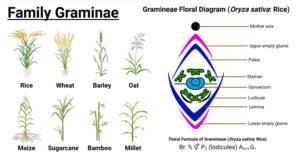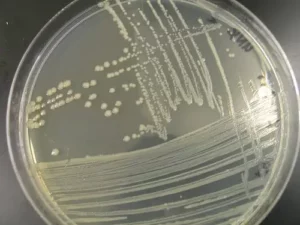Green Algae (Chlorophyta) consists of a diverse range of photosynthetic organisms in different habitats like freshwater and marine ecosystems. They display a distinctive green hue owing to the presence of chlorophyll a and b which are essential for photosynthesis. Green algae contribute to the production of oxygen in the aquatic ecosystem and act as the foundation for the majority of aquatic food webs.

Characteristic Features of Green Algae (Chlorophyta)
- Green algae have different morphological forms such as unicellular, colonial, filamentous, or multicellular. Their cell membrane is mainly made up of cellulose.
- They have chloroplasts where photosynthesis takes place. Certain species might also have pyrenoids which participate in the creation and storage of starch.
- Green algae contain chlorophyll a and b, which give them their green hue. These pigments help in the absorption of light energy for the purpose of photosynthesis. Along with chlorophylls, green algae are also rich in carotenoids, which assist in light absorption and contribute to protecting cells from light-induced oxidation.
- They reproduce through both asexual and sexual methods. Asexual reproduction occurs via the creation of zoospores, while sexual reproduction happens through isogamy, Anisogamy, or oogamy.
- Some species of green algae have both haploid (gametophytic) and diploid (sporophytic) life cycle phases, which represent alternation of generations.
- Green algae flourish in a range of habitats, such as freshwater, marine ecosystems, and soil, and even in symbiotic associations with other organisms like lichens or corals.
- Green algae play a vital role in producing oxygen production in aquatic systems. They constitute the foundation of the majority of aquatic food chains, acting as sustenance for many herbivorous creatures.
Classes of Green Algae (Chlorophyta)
Green algae can be categorized into different groups based on their characteristics, as outlined below-
Chlorophyceae
- The class Chlorophyceae is the biggest and most varied within the green algae, found in both freshwater and marine aquatic ecosystems.
- They are mainly unicellular or multicellular, although certain species occur in colonial or filament-like shapes.
- They can reproduce in both sexual and asexual ways. Asexual reproduction typically occurs through mobile zoospores, while sexual reproduction involves the fusion of gametes (isogamy, anisogamy, or oogamy).
- Examples: Chlamydomonas (unicellular), Volvox (colonial), Cladophora (filamentous).


Ulvophyceae
- The Ulvophyceae class members are primarily marine algae, including species that form large structures like sea lettuce.
- They are primarily multicellular and grow extensive thalloid structures like tubes, sheets, or fibers.
- They sexually reproduce through gamete formation and reproduce asexually by creating zoospores, and some exhibit the alternation of generations throughout their life cycle.
- Examples: Ulva (sea lettuce), Codium (dead man’s fingers)
Trebouxiophyceae
- This class comprises both freshwater and oceanic green algae, with the majority of the species being single-celled or forming tiny colonies.
- These algae generally have a unicellular structure. They establish symbiotic connections with fungi, as seen in lichens.
- Asexual reproduction through the creation of zoospores is common, yet sexual reproduction also occurs in specific species.
- Examples: Trebouxia, Chlorella
Habitats of Green Algae (Chlorophyta)
Green algae (Chlorophyta) can be found in a variety of habitats. While they primarily thrive in aquatic environments, they also exist in terrestrial habitats and symbiotic relationships.
Freshwater Habitats
Green algae such as Chlamydomonas are plentiful in freshwater habitats like ponds, lakes, rivers, and streams.
Marine Habitats
Most green algae are oceanic species that fulfill crucial functions in coastal and shallow marine ecosystems. They inhabit the intertidal area, coral reefs, and the seabed. Examples: Ulva (sea lettuce), Codium.
Soil and Terrestrial Habitats
Some Chlorella species can also be located in wet, humid land regions.
Symbiotic Habitats
Some green algae establish symbiotic relationships with fungi (lichens)), corals. Lichens are formed through the symbiosis of fungi and green algae, where the algae perform photosynthesis and supply sustenance to the fungal associate.
Examples: Trebouxia.
Ecological Functions of Green Algae (Chlorophyta)
Green algae are vital in aquatic ecosystems as the main producers. They harness sunlight and transform it into chemical energy via photosynthesis, creating the foundation of the food chain in this ecosystem and also release oxygen as a by-product of photosynthesis, which is essential for the respiration of other living beings.
Green algae contribute to nutrient cycling in water-based ecosystems. They take in inorganic nutrients such as phosphorus and nitrogen, and when they decompose, they release these nutrients back into the environment, promoting the development of other organisms.
They also act as a food source for several herbivores, such as zooplankton, small fish, and certain invertebrates.
Life Cycles and Reproduction in Green Algae (Chlorophyta)
Green algae display a variety of reproductive methods, encompassing both asexual and sexual reproduction.
Asexual Reproduction
Binary Fission– Unicellular algae generally reproduce asexually via binary fission, in which one cell splits to form two genetically identical offspring cells. Example- Chlamydomonas.
Fragmentation– Certain multicellular green algae propagate asexually using fragmentation, which entails a part of the thallus separating and evolving into a new life form. Example- Cladophora.
Zoospores– Many green algae generate motile, flagellated zoospores that swim in the water and ultimately develop into new individuals. Example- Cladophora.
Sexual Reproduction
Isogamy– In certain species, the male and female gametes are similar in structure. These gametes combine during fertilization to form a zygote.
Anisogamy– In this type of reproduction, the merging occurs between the gametes which vary in structure yet are both mobile.
Oogamy– This reproduction method involves the fusion of large, immobile female gametes (eggs) and small, mobile male gametes combined to create a zygote.
Zygotic Meiosis– In most green algae, meiosis takes place following fertilization, resulting in haploid cells and completing the sexual life cycle.
Alternation of Generations
Some green algae, such as Ulva, exhibit alternation of generations, between a haploid (gametophyte) phase and a diploid (sporophyte) phase throughout their life cycle. This process encourages genetic diversity and improves adaptability within the species.
Economic and industrial uses of Green Algae (Chlorophyta)
Green algae possess a broad spectrum of economic and industrial uses owing to their varied biochemical characteristics, fast growth rates, and capacity to flourish in different conditions.
Biofuel Production
Green algae, notably Chlorella and Scenedesmus, are crucial in the production of biofuels. They have the capability to generate lipids and different bioactive substances, which can be converted into biofuel.
Algae-based biofuels are considered a renewable and sustainable source of energy that can lessen dependence on fossil fuels.
Nutritional Supplements
Chlorella and Spirulina are utilized as nutritional supplements because of their rich content of protein, vitamins, and minerals. They are plentiful in antioxidants, omega-3 fatty acids, and vital amino acids. Green algae are frequently used in dietary supplements, protein shakes, and energy snacks.
Wastewater Treatment
Chlorophyta serves an essential function in wastewater management systems by assisting in the removal of surplus nutrients such as nitrogen and phosphorus. Algae-based approaches are eco-friendly and more economical than conventional techniques.
Chlorella and other green algae are employed for the treatment of industrial effluent and agricultural runoff.
Applications in Agriculture
Green algae act as natural fertilizers and soil improvements in the agriculture industry. Their growth enhances soil productivity by enhancing nutrient availability.
Aquaculture and Animal Feed
Green algae, including Spirulina and Chlorella, are used in aquaculture as feed additives for fish and shrimp. They are abundant in proteins, vitamins, and crucial fatty acids. Algae are additionally added to animal nutrition to enhance the well-being and development of livestock.
Cosmetics and Pharmaceuticals
Compounds derived from green algae, including carotenoids, antioxidants, and polysaccharides, are incorporated into cosmetic and skincare products for their moisturizing and anti-aging benefits. Certain green algae, notably Chlorella, are utilized in the manufacturing of pharmaceuticals, especially for boosting the immune system and treating cancer.
Green Algae in Symbiotic Relationships
Green algae participate in multiple symbiotic interactions with different organisms, aiding in ecological equilibrium and shared benefits.
A prime illustration of a symbiotic connection involving green algae is lichens. Lichens symbolize a mutualistic partnership between fungi and green algae (or cyanobacteria). The algae engage in photosynthesis, supplying carbohydrates for the fungus, whereas the fungus presents protection from desiccation and harsh environmental circumstances.
For instance, Trebouxia (green algae) has a symbiotic relationship with Cladonia (fungus) in lichens.
Zooxanthellae, a type of green algae, inhabit the tissues of coral polyps. The algae conduct photosynthesis and supply nutrients to the corals, whereas the corals provide a safe habitat in addition to nourishment for the algae. This symbiotic connection is crucial for coral reef ecosystems, particularly in oceanic settings where nutrient concentrations are minimal.
Evolutionary Significance of Green Algae (Chlorophyta)
The evolutionary significance of Chlorophyta(green algae) is widespread, as they are considered one of the most significant categories in the timeline of plant development. It is thought that green algae are the forebears of contemporary terrestrial plants, and examining them offers important understanding of the evolutionary shift from aquatic to terrestrial habitats.
- Green algae are believed to have originated from a common ancestor that they share with terrestrial plants. They are categorized within the Viridiplantae group, which includes all terrestrial vegetation.
- Both green algae and land-based plants exhibit numerous crucial traits, including the existence of chlorophyll a and b, comparable cell wall compositions formed from cellulose, and starch utilized as their reserve carbohydrate.
- The shift from water-based algae to land plants probably required adaptations that facilitated survival in terrestrial environments, such as the formation of cuticles, vascular systems, and strategies to avoid dehydration.
- Green algae have been crucial in the development of numerous symbiotic interactions, including their partnership with fungi to form lichens and their connection with corals to produce vital symbiotic algae (zooxanthellae).
- Molecular phylogenetic studies have emphasized the strong connection between green algae and land-dwelling plants, affirming that both chlorophytes and charophytes represent initial lineages within the plant kingdom.
- Charophytes such as Chara and Coleochaeteare considered to be the closest relatives of terrestrial plants, exhibiting various structural similarities in their reproductive structures and gametes.
- Green algae have experienced notable evolutionary progress, such as the emergence of intricate multicellularity and the division of functions in multicellular organisms (for example, unique reproductive structures).
- Certain green algae, like Cladophora, exhibit the alternate generations, an essential evolutionary characteristic that is also present in contemporary plants.
Key Genera and Species in Green Algae (Chlorophyta)
Several genera and species within the Chlorophyta possess significance because of their environmental functions, financial importance, and evolutionary traits.
Chlamydomonas
Chlamydomonas is a unicellular genus of green algae frequently utilized in scientific research, especially in the examination of photosynthesis and cellular biology. This genus possesses two flagella for locomotion and has the ability for both sexual and asexual reproduction. Chlamydomonas reinhardtii acts as a model species for genetic and biofuel studies.
Chlorella
Chlorella is a genus of tiny, spherical, single-celled algae that are rich in proteins, vitamins, and various vital nutrients. They hold commercial importance as dietary supplements, in aquaculture, and as raw materials for biofuels. The most well-known species within this genus is Chlorella vulgaris.
Ulva
Ulva, commonly referred to as sea lettuce, is a group of multicellular marine green algae, recognized for its straightforward, slender, and sheet-like form. Species of Ulva are valuable for their economic worth as food sources and act as measures of water quality because of their sensitivity to contaminants. Ulva lactuca among the most recognized varieties utilized in cooking traditions throughout East Asia.
Scenedesmus
Scenedesmus is a genus of aquatic green algae typically located in nutrient-dense environments like lakes and ponds. They create colonial groups and are the focus of study because of their capacity to generate biofuels.
Cladophora
Cladophora is a genus of green algae noted for its long, branched filaments. It is commonly found in freshwater habitats. Its environmental importance is remarkable, as it can aid in nutrient cycles within aquatic ecosystems and may result in blooms under eutrophic circumstances.
Codium
Codium is made up of marine green algae that display a gentle, porousthallus. They flourish in coastal ocean environments, especially in temperate waters and the Mediterranean. In some regions,they act as a food supply and are crucial for sustaining the wellbeing of marine ecosystems.
Trebouxia
Trebouxia is a genus of green algae that is essential in the development of lichens. These algae provide energy to their fungal counterparts via photosynthesis.
Study and Future Opportunities in Green Algae Research
Green algae remain an important subject of scientific research because of their ecological, evolutionary, and industrial significance. Upcoming studies are expected to concentrate on various crucial aspects:
Biofuel Production: Ongoing research examines green algae as possible resources for biofuel generation, to enhance lipid production effectiveness and fine-tuning growth conditions for extensive farming. Genetic alterations in green algae could also increase their biofuel production, making them a more feasible renewable energy option.
Carbon Sequestration: Green algae are essential for carbon fixation via photosynthesis, aiding in the reduction of climate change. Studies are centered on employing algae for extensive carbon sequestration systems to reduce atmospheric CO2 levels. The incorporation of algal carbon sequestration may play a role in upcoming strategies for mitigating climate change.
Environmental Biotechnology: Green algae have substantial promise in the domain of environmental biotechnology, especially for wastewater treatment. They are capable of taking up contaminants and surplus nutrients from aquatic environments, enhancing overall water quality and reducing eutrophication. Additionally, algae can aid in removing heavy metals and organic pollutants from polluted water bodies.
Agricultural and Aquaculture Applications: Studies are being carried out on the use of green algae in farming as organic pest control and biofertilizers. Fertilizers derived from algae are eco-friendly and could improve crop production and soil fertility. Additionally, research is investigating the application of green algae to enhance the health and growth rates of fish and various aquatic species in aquaculture environments.
Food and Nutraceuticals: For many years, algae, especially Chlorella and Spirulina, have been utilized as nutritional additives. Ongoing research is assessing the alleged health advantages of green algae, including their antioxidant, anti-inflammatory, and immune-boosting characteristics. The marketing of algae-derived foods is expected to expand, especially as a sustainable nutrition option for an increasing worldwide population.
Space Exploration: Green algae are currently being examined for their possible uses in space exploration. Their ability to perform photosynthesis and generate oxygen makes them suitable for systems that provide life support within habitats in space.
References
- Seaweed.ie :: Chlorophyta. (n.d.). https://www.seaweed.ie/algae/chlorophyta.html
- Kennedy, J. (2019, March 18). Green algae (Chlorophyta). ThoughtCo. https://www.thoughtco.com/green-algae-chlorophyta-2291973
- Phylogeny and molecular evolution of the green algae. (2018, September 26). Frederik Leliaert. https://frederikleliaert.wordpress.com/green-algae/phylogeny-and-molecular-evolution/
- Manisha, M. (2016, September 6). Green Algae: Characters and Economic Importance (With Diagram). Biology Discussion. https://www.biologydiscussion.com/algae/green-algae-characters-and-economic-importance-with-diagram/52153
- Lewis, L. (2015, September 6). Symbiotic Green algae. Louise Lewis Lab. https://algae.eeb.uconn.edu/research-interests/symbiotic-green-algae/
- N, M. (2016, October 17). Evolutions of chlorophyta | Algae. Biology Discussion. https://www.biologydiscussion.com/algae/evolutions-of-chlorophyta-algae/57904
- GeeksforGeeks. (2022, October 21). Chlorophyceae. GeeksforGeeks. https://www.geeksforgeeks.org/chlorophyceae/
- Behera, S., Singh, R., Arora, R., Sharma, N. K., Shukla, M., & Kumar, S. (2015). Scope of algae as third generation biofuels. Frontiers in Bioengineering and Biotechnology, 2. https://doi.org/10.3389/fbioe.2014.00090
- Arora, K., Kumar, P., Bose, D., Li, X., & Kulshrestha, S. (2021). Potential applications of algae in biochemical and bioenergy sector. 3 Biotech, 11(6). https://doi.org/10.1007/s13205-021-02825-5
- Ijraset. (n.d.). A Review on Application and Future prospects of Algae in Pharmaceutical and Food industry. IJRASET. https://www.ijraset.com/research-paper/application-and-future-prospects-of-algae



